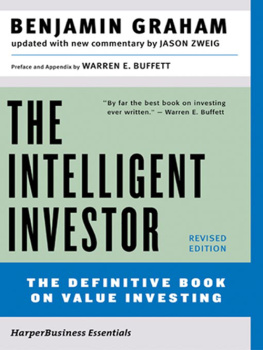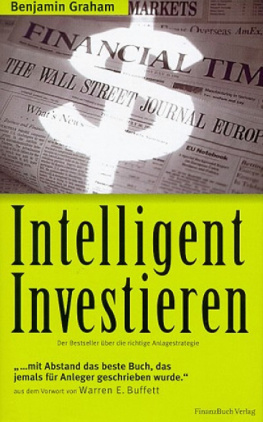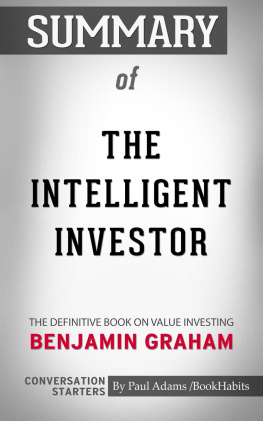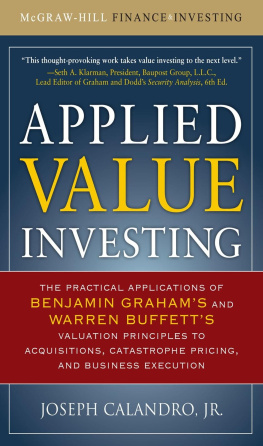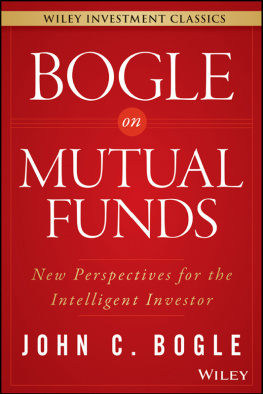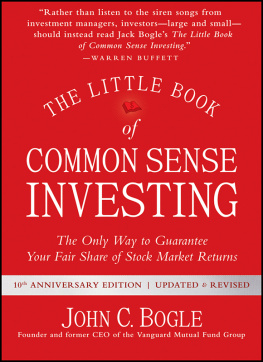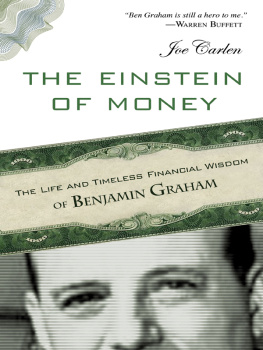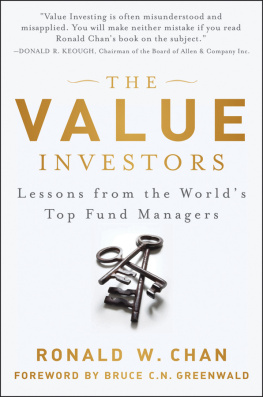SECURITY ANALYSIS
The quality of the materials used in
the manufacture of this book is governed
by continued postwar shortages.
Many shall be restored that now are fallen and many
Shall fall that now are in honor.
HORACEArs Poetica.
SECURITY ANALYSIS
Principles and Technique
BY
BENJAMIN GRAHAM
Investment Fund Manager; Lecturer in
Finance, Columbia University
AND
DAVID L. DODD
Associate Professor of Finance
Columbia University
SECOND EDITION


Copyright 1934 by The McGraw-Hill Companies, Inc. All rights reserved. Except as permitted under the United States Copyright Act of 1976, no part of this publication may be reproduced or distributed in any form or by any means, or stored in a database or retrieval system, without the prior written permission of the publisher.
ISBN: 978-0-07-170757-2
MHID: 0-07-170757-3
The material in this eBook also appears in the print version of this title: ISBN: 978-0-07-141228-5, MHID: 0-07-141228-X.
All trademarks are trademarks of their respective owners. Rather than put a trademark symbol after every occurrence of a trademarked name, we use names in an editorial fashion only, and to the benefit of the trademark owner, with no intention of infringement of the trademark. Where such designations appear in this book, they have been printed with initial caps.
McGraw-Hill eBooks are available at special quantity discounts to use as premiums and sales promotions, or for use in corporate training programs. To contact a representative please e-mail us at bulksales@mcgraw-hill.com.
TERMS OF USE
This is a copyrighted work and The McGraw-Hill Companies, Inc. (McGraw-Hill) and its licensors reserve all rights in and to the work. Use of this work is subject to these terms. Except as permitted under the Copyright Act of 1976 and the right to store and retrieve one copy of the work, you may not decompile, disassemble, reverse engineer, reproduce, modify, create derivative works based upon, transmit, distribute, disseminate, sell, publish or sublicense the work or any part of it without McGraw-Hills prior consent. You may use the work for your own noncommercial and personal use; any other use of the work is strictly prohibited. Your right to use the work may be terminated if you fail to comply with these terms.
THE WORK IS PROVIDED AS IS. McGRAW-HILL AND ITS LICENSORS MAKE NO GUARANTEES OR WARRANTIES AS TO THE ACCURACY, ADEQUACY OR COMPLETENESS OF OR RESULTS TO BE OBTAINED FROM USING THE WORK, INCLUDING ANY INFORMATION THAT CAN BE ACCESSED THROUGH THE WORK VIA HYPERLINK OR OTHERWISE, AND EXPRESSLY DISCLAIM ANY WARRANTY, EXPRESS OR IMPLIED, INCLUDING BUT NOT LIMITED TO IMPLIED WARRANTIES OF MERCHANTABILITY OR FITNESS FOR A PARTICULAR PURPOSE. McGraw-Hill and its licensors do not warrant or guarantee that the functions contained in the work will meet your requirements or that its operation will be uninterrupted or error free. Neither McGraw-Hill nor its licensors shall be liable to you or anyone else for any inaccuracy, error or omission, regardless of cause, in the work or for any damages resulting therefrom. McGraw-Hill has no responsibility for the content of any information accessed through the work. Under no circumstances shall McGraw-Hill and/or its licensors be liable for any indirect, incidental, special, punitive, consequential or similar damages that result from the use of or inability to use the work, even if any of them has been advised of the possibility of such damages. This limitation of liability shall apply to any claim or cause whatsoever whether such claim or cause arises in contract, tort or otherwise.

The first edition of Security Analysis, published
in 1934, forever changed the theory and practice of successful
investing. Yet the remainder of that tumultuous decade brought
unprecedented upheaval to the financial world. In 1940, Benjamin
Graham and David Dodd were compelled to produce a comprehensively
revised second edition. For that reason, Security Analysis, Second
Edition, is considered by many investors to be vastly superior
to the first and the final word from one of the most influential
investment philosophers of our time.
Security Analysis, now in its fifth edition, is regarded around the
world as the fundamental text for the analysis of stocks and bonds,
as well as the bible of value investing. To commemorate the books
great achievement, and to reintroduce to readers the ideas and
language of the celebrated second edition, McGraw-Hill is
proud to publish this special reproduction
of the 1940 edition.
This special reprint edition was photographed by hand from the
original pages of the second edition by Jays Publishers Services,
Inc., Rockland, Massachusetts. A customized vertical camera,
designed to minimize distortion and to prevent damage to
rare books, was used. This edition was printed and bound
by R.R Donnelley, Crawfordsville, Indiana.

To
ROSWELL C. McCREA
PREFACE TO THE SECOND EDITION
The lapse of six years since first publication of this work supplies the excuse, if not the necessity, for the present comprehensive revision. Things happen too fast in the economic world to permit authors to rest comfortably for long. The impact of a major war adds special point to our problem. To the extent that we deal with investment policy we can at best merely hint at the wars significance for the future. As for security analysis proper, the new uncertainties may complicate its subject matter, but they should not alter its foundations or its methods.
We have revised our text with a number of objectives in view. There are weaknesses to be corrected and some new judgments to be substituted. Recent developments in the financial sphere are to be taken into account, particularly the effects of regulation by the Securities and Exchange Commission. The persistence of low interest rates justifies a fresh approach to that subject; on the other hand the reaffirmance of Wall Streets primary reliance on trend impels us to a wider, though not essentially different, critique of this modern philosophy of investment.
Although too great insistence on up-to-date examples may prove something of a boomerang, as the years pass swiftly, we have used such new illustrations as would occur to authors writing in 1939-1940. But we have felt also that many of the old examples, which challenged the future when first suggested, may now possess some utility as verifiers of the proposed techniques. Thus we have borrowed one of our own ideas and have ventured to view the sequel to all our germane 1934 examples as a laboratory test of practical security analysis. Reference to each such case, in the text or in notes, may enable the reader to apply certain tests of his own to the pretensions of the securities analyst.
The increased size of the book results partly from a larger number of examples, partly from the addition of clarifying material at many points and perhaps mainly from an expanded treatment of railroad analysis and the addition of much new statistical material bearing on the exhibits of all the industrial companies listed on the New York Stock Exchange. The general arrangement of the work has been retained, although a few who use it as a text have suggested otherwise. We trust, however, that the order of the chapters can be revised in the reading, without too much difficulty, to convenience those who prefer to start, say, with the theory and practice of common-stock analysis.
Next page

